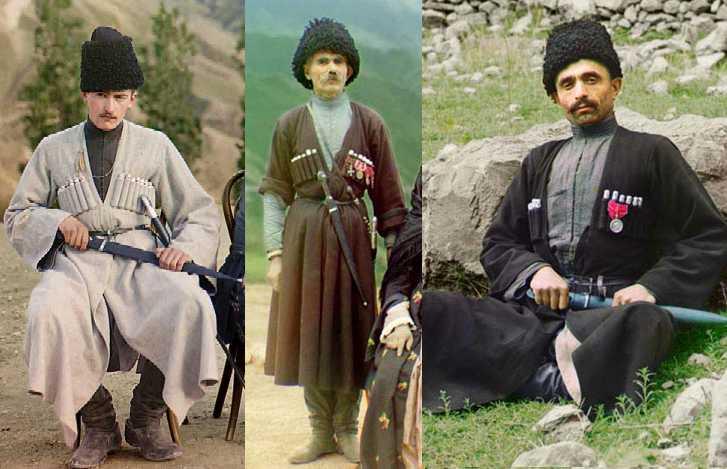
Caucasian Moutaineers

These men are Dagestanis from around 1910.
Many units were formed in the the White Armies of South Russia from Caucasian mountaineers, but they tend to be rather obscure in the historical literature, since their members were not part of the literate White elite who wrote their memoirs in exile.
Dress
The Caucasian Mountaineers wore their traditional dress in normal life, and in the Russian Civil War men turned up to serve in what they had. We can expect that they would therefore be extremely varied in colour and style.
Most of the Caucasians were quite poor: the prospect of loot being a prime reason for serving, whereas men with property to protect had every reason to stay in their villages. It seems likely that the units of the RCW would be fairly dull as a result, and many may even have been wearing ordinary military coats, rather than cherkeskas, due to poverty.
Most of their senior officers however were likely local nobility, serving out of allegiance to the old regime. A fair few bear titles like Sultan.
Each regiment of the Savage Division in WWI also had a mullah, and it seems that they preferred white horses.
Mountain Units in the RCW
The Russians had not entirely pacified the Caucasus until quite late: there were serious military uprisings up until 1877. As a result the local tribes were not integrated into the Russian Imperial army in large numbers. There was a small Dagestani unit and some Ossetians, and that was about it. Russia's need for men in WWI however lead to recruitment in new places, and the result was a division entirely recruited from the Caucasus mountains. The famous Дикая дивизия (normally translated as "Savage Division", although "Wild Division" is perhaps better) served with distinction and notoriety.
The Savage Division was implicated in the "Kornilov Affair" but persuaded from attacking. After that the men started to return home.
Throughout the Civil War the bulk of the Caucasian tribesmen stayed in their homelands, where they set up a couple of short-lived Mountain governments and fought local Reds, Whites and Cossack nationalists alike. While not unhappy with the overthrow of the Tsarist system, very few sided with the Bolsheviks. An intense attachment to their traditions, particularly religion, and independent mindedness were not compatible with Atheism and centralisation.
By late 1919 most major ethnic groups of the Caucasus were represented by regiments in the AFSR, but usually in small numbers. A few units had joined the Volunteer Army quite early, but most were raised after the second Kuban campaign. Most of these units collapsed with the retreat to the Kuban and Terek in early 1920.
Less than 2,000 mountaineers made it to the White army in the Crimea. Initially they were formed into a 1st and 2nd Native Regiments, but they were given a very low priority for horses and equipment and these two units seem to have been disbanded before the major breakout campaigns. It is not clear what happened to the men.
For the period they did serve the White Army, the Caucasians were noted for their bravery in battle. And their tendency to loot away from it.
The Red Army swept quickly into the Caucasus in 1920. No major resistance was offered at first, but it was not long before Bolshevik impositions caused friction. Dagestan was soon the site of major battles between the natives and Soviet forces.
We have collected some period photos of Caucasian mountaineers in military dress.